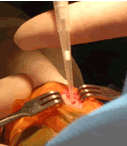CBE researchers at MIT are using stem cells and "self-assembling" peptide scaffolds for tissue engineering. MIT has a partnership with Centocor (J&J) on cartilage degradationin osteoarthritis patients. A recent study done on rabbits shows how injectable peptide gels are used as a new material that can fill osteochondral defects and promote the reparation of cartilage. These peptide scaffold deliver growth factors and stem cells to joint lesions as well. This peptide was then further analyzed by collaborators in Clinical Sciences, Colarado State University, and CBE faculty at MIT. They performed a research on horses, using the peptide to repair defects in their knees. This gave the researchers a better look at how the peptide would act in a human.
Another group of researchers used the self-assembling peptide to create a microenvironment for liver morphogenesis and growth. They did this by using the peptide with adhesive modifications and tethered epidermal growth factor. Results show that peptides are promising for long-term culture of hepatocytes.
Therefore, these self-assembling peptides are being analyzed to make cartilage and hepatocytes by various researchers. They show a very promising and convenient outcome and perhaps even an overlook on the future in cell and tissue engineering.

No comments:
Post a Comment